Related Research Articles

The London and North Eastern Railway (LNER) was the second largest of the "Big Four" railway companies created by the Railways Act 1921 in Britain. It operated from 1 January 1923 until nationalisation on 1 January 1948. At that time, it was divided into the new British Railways' Eastern Region, North Eastern Region, and partially the Scottish Region.
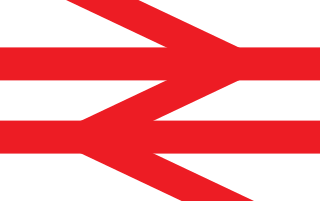
The United Kingdom consists of Great Britain and Northern Ireland, and previously consisted of Great Britain and the whole of Ireland. Rail transport systems developed independently on the two island masses of Great Britain and Ireland, and most of the railway construction in the Republic of Ireland was undertaken before the creation of the Irish Free State in 1922. Thus, the logical division to discuss the history and present-day state of railways in these areas is by geographical division, rather than the nationalist division of nation states.
The London and North Eastern Railway (LNER) produced several classes of locomotive, mostly to the designs of Nigel Gresley, characterised by a three-cylinder layout with a parallel boiler and round-topped firebox. It produced the most famous locomotive of its day, 4468 'Mallard', the holder of the world steam locomotive speed record. It also built the world-famous 4472 'Flying Scotsman'. However, its locomotive inheritance was much greater than just the 'A4 Class', it also produced highly successful mixed-traffic and freight designs.

Dingwall railway station serves Dingwall, Scotland. It is located just south of the junction of the Far North Line and the Kyle of Lochalsh Line, and is served by ScotRail. The station is 18 miles 58 chains (30.1 km) from Inverness, and is the zero point for the Kyle of Lochalsh Line. It is sited after Conon Bridge heading northbound, with the next station being either Garve or Alness.

The NBR K class is a class of 4-4-0 steam locomotive of the North British Railway. The first batch was designed by Matthew Holmes in 1902 and had 6-foot-6-inch (1.981 m) driving wheels for express passenger work. Three more batches were designed by William P. Reid with 6-foot-0-inch (1.829 m) driving wheels for mixed traffic work. This included perishable goods, such as fish from Mallaig and Aberdeen. They had inside cylinders and Stephenson valve gear. The D34 locomotives, commonly known as Glen Class, were built with superheaters. The LNER later fitted superheaters to all D26, D32, and D33 engines as well. All engines of the K class are sometimes known as Glen Class, although the designation is strictly reserved to the fourth (D34) batch.
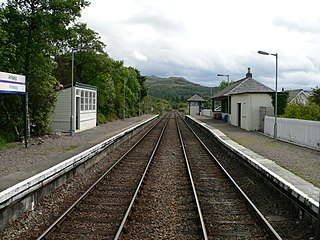
Arisaig railway station serves the village of Arisaig on the west coast of the Highland region of Scotland. This station is on the West Highland Line, 34 miles (55 km) west of Fort William on the way to Mallaig. The westernmost station on the Network Rail network, it is the only one of the four cardinal points of the national network that is not a terminus.
The Scottish Region (ScR) was one of the six regions created on British Railways (BR) and consisted of ex-London, Midland and Scottish Railway (LMS) and ex-London and North Eastern Railway (LNER) lines in Scotland. It existed from the creation of BR in 1948, and was renamed to ScotRail in the mid-1980s.
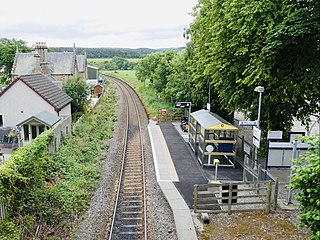
Beauly railway station is a railway station in the village of Beauly, in the Highland council area of Scotland. Located on the Far North Line, it is 10 miles 12 chains (16.3 km) down the line from Inverness, and it is the first intermediate station on the line, before reaching Muir of Ord.

Spean Bridge railway station is a railway station serving the village of Spean Bridge in the Highland region of Scotland. This station is on the West Highland Line.
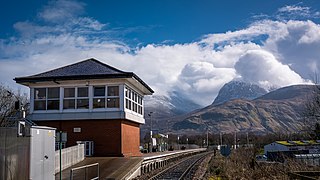
Banavie railway station is a railway station on the West Highland Line serving the village of Banavie, although it is much closer to Caol, Scotland. To continue on to the next station at Corpach, trains must pass over the Caledonian Canal at Neptune's Staircase, a popular tourist attraction.

Dunkeld & Birnam railway station serves the towns of Dunkeld and Birnam in Perth and Kinross, Scotland. It is located on the Highland Main Line, 15 miles 31 chains (24.8 km) north of Perth and is the first stop on the line north of there. It has a passing loop 28 chains (560 m) long, flanked by two platforms. Platform 1 on the up (southbound) line can accommodate trains having twelve coaches, but platform 2 on the down (northbound) line can only hold ten. When no crossing is to be made, northbound trains are usually routed through platform 1 which is signalled for bi-directional running.

Rolleston station is around half a mile from the small village of Rolleston, one of the Trent side villages close to Southwell in Nottinghamshire, England. The station is convenient for Southwell Racecourse, to which it is adjacent.
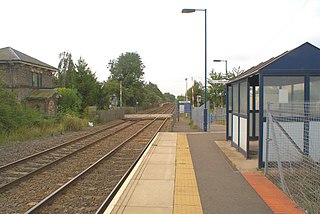
Bleasby railway station serves the village of Bleasby, Nottinghamshire, England. It is on the Nottingham to Lincoln Line, owned by Network Rail and managed by East Midlands Railway.

Night Mail is a 1936 British documentary film directed and produced by Harry Watt and Basil Wright, and produced by the General Post Office (GPO) Film Unit. The 24-minute film documents the nightly postal train operated by the London, Midland and Scottish Railway (LMS) from London to Scotland and the staff who operate it. Narrated by John Grierson and Stuart Legg, the film ends with a "verse commentary" written by W. H. Auden to a score composed by Benjamin Britten. The locomotive featured in the film is LMS Royal Scot Class 6115 Scots Guardsman.
The Leadhills and Wanlockhead Light Railway was a short branch railway built in Scotland to serve mining settlements, high in the Lowther Hills, connecting them to the Carlisle - Carstairs main line. The line was opened in 1901 - 1902, and was the highest standard gauge railway line in the British Isles. Hoped-for developments did not emerge, and when the world lead price slumped in the 1920s, the line sustained heavy losses. It was closed on 2 January 1939.
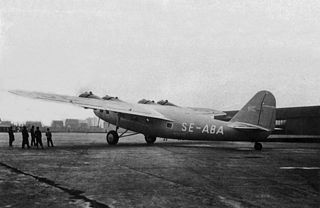
The Fokker F.XXII was a 1930s Dutch four-engined 22-passenger airliner designed and built by Fokker.

Seven Sinners is a 1936 British thriller film directed by Albert de Courville and starring Edmund Lowe, Constance Cummings and Felix Aylmer. In the U.S. it was known under this title and also as Doomed Cargo. The screenplay concerns an American detective and his sidekick, who travel from France to England to take on a gang of international criminals.

The LNWR 4ft 6in Tank was a class of 220 passenger 2-4-2T locomotives manufactured by the London and North Western Railway in their Crewe Works between 1879 and 1898. The "4ft 6in" in the title referred to the diameter of the driving wheels – although the stated dimension was for the wheel centres – the nominal diameter including the tyres was 4 ft 8+1⁄2 in (1,435 mm).
The Orcadian was a named passenger train operating in the United Kingdom.
References
- ↑ Allen, Cecil J. (1967). Titled Trains of Great Britain. Ian Allan Ltd. p. 97.
- ↑ "Trains With Names" . The Scotsman. Scotland. 4 April 1936. Retrieved 22 November 2017– via British Newspaper Archive.